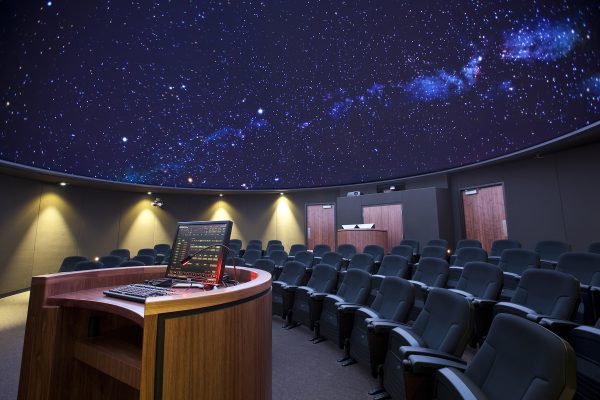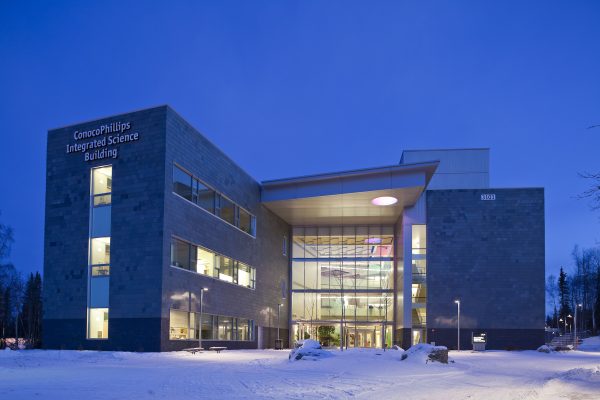Plan a trip to the planetarium
by joey |

The UAA Planetarium & Visualization Theater combines education and entertainment by hosting regular Friday night double features, frequently hosted by faculty presenters. (Photos by Chris Arend)
Ignore the name. Planetariums aren't just for planets. The UAA Planetarium and Visualization Theater, in fact, holds shows on everything from physics to biology, and even math (yes, math).
Used during the week for field trips, school groups and college-level astronomy classes, the planetarium opens its doors to the public most Fridays of the academic year. It's second only to Athletics in the amount of people it brings to campus, and there's good reason for that. Planetarium shows provide an unmatchable opportunity not just to meet a professor, but to ask them any question you have.
"Whenever we bring someone into the planetarium, whether it's a school group or the public, we do much more than just press play and sit back and let them watch something that somebody else produced," said Erin Hicks, planetarium director and professor of physics and astronomy. Instead, they run a regular show for 20-25 minutes, then fill the rest of the hour with a discussion and Q&A. Sometimes the entire event is explained live as well. Presenters rotate, and the conversations vary; some faculty talk about their research, others explain what NASA's up to next.

'Fractals Rock' is a regular Planetarium production hosted by faculty from the math department. (Image courtesy UAA Planetarium and Visualization Theater)
"Usually I will have to say, 'Okay, we're 15 minutes over. I'll let you guys go, but I'll be up front if you have more questions.' And they always have more to ask," said Hicks. That adds an extra energy to education. "Black holes are my area of research, and it is easy to get caught up in the details of that work, but presenting for a public audience always reminds me just how awe-inspiring black holes are."
With a rotation of faculty presenters, no two screenings are alike. Hicks noted some guests return again and again to watch for the same show, just to hear a different perspective from that night's professor.
"Half of it is brand new to them, depending on who's standing up front," she said.
Fly me to Jupiter's moon
Shows this semester include a talk from a visiting University of Wales astronomer, a trip through ever-expanding fractals with three math professors, and an earthquake experience with Simon Kattenhorn, director of the Department of Geological Sciences.
Kattenhorn first came to UAA as a one-night planetarium presenter, while in Anchorage for a sabbatical with the U.S. Geological Survey. Sitting snugly in the 60-seat auditorium, the audience angled to the domed roof, Kattenhorn took the crowd on a trans-planetary virtual flight to Jupiter's icy moon, Europa, the subject of his personal research.
"It's a great learning experience for kids, but it's also a great learning opportunity for adults," Kattenhorn said. "To this day, it has been the most fun presentation I have ever given in my professional career."
A professor at University of Idaho at the time, that one evening convinced him to return. He'll present Earthquake on March 30 in a faculty-led double feature with Dynamic Earth, only this time, he's not on a sabbatical.
"Now, I work here," Kattenhorn said with a laugh.

The UAA Planetarium and Visualization Theater is housed inside the ConocoPhillips Integrated Science Building. Parking is free for Friday films. (Photos by Chris Arend)
Bringing Alaska to the screen
The planetarium opened in 2009, along with the ConocoPhillips Integrated Science Building, but it was always intended to be a public venue.
"When this building was designed, the idea of the public square - which is still an important part of UAA - was firmly in focus in our minds," said Travis Rector, a professor of physics and astronomy who served as the theater's first director. "The philosophy of our shows is we want people to come to campus to learn."
Rector takes that goal a step further. He's now producing his fourth show specially for the UAA planetarium, and each one is focused on Alaska.

'River of Bears,' which premiered in 2014, was the first of several movies produced through UAA's planetarium.
"It didn't make sense for us to create shows that other people had already done, so we decided we want to make shows about Alaska," he said.
The planetarium premiered Rector's first production, River of Bears, in 2013. Filmed at McNeil River Game Sanctuary, the movie provides incredible visuals of a place few can visit. Only limited lottery winners can access McNeil River each year but, through the planetarium, thousands can experience the park each day.
The movie screened at national film festivals, and has the distinction of being the first live-action wildlife movie specifically shot for planetarium screens. Rector has since produced Above Alaska, which shares the experience of a night under the aurora, and assisted in Kiuguyat: The Northern Lights, which shares Alaska Native traditions and contemporary research related to the aurora. His fourth project, centered on climate change, brought him and the camera crew to the enormous walrus haulouts of Round Island.
Rector, his colleagues, and his films make the UAA Planetarium and Visualization Theater a unique venue for education and entertainment.
"The whole point of the public square and the planetarium ... is for people to learn about Alaska," he said. "We're telling the story of Alaska."
https://vimeo.com/101663499
Friday night shows frequently sell out. See the upcoming schedule and get your tickets online.
Related stories:
- Astronomer Travis Rector's new book uses art to see the science in space
- Geological Society of America names Simon Kattenhorn as a fellow
- Bears take over the planetarium
- The total eclipse of Talkeetna, 1963
 "Plan a trip to the planetarium" is licensed under a Creative Commons Attribution-NonCommercial 4.0 International License.
"Plan a trip to the planetarium" is licensed under a Creative Commons Attribution-NonCommercial 4.0 International License.














